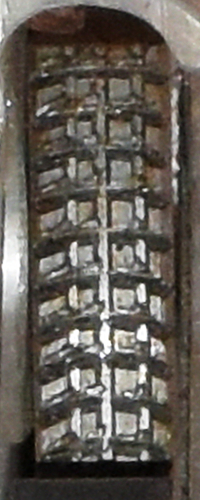Technical Details
I acquired two right-hand ascenders from Artyom Babin (Артём Бабин) in 2021. He originally believed that these most likely were produced at the Krasnoyarsk Aircraft Repair Plant, but later research showed that they were made at the Krasnoyarsk TV Factory.
 The Krasnoyarsk TV Factory (Красноярский Завод Телевизоров) ascender is 180 mm. tall, 72 mm. wide, 32 mm. thick, and weighs 269 g. The body is milled from aluminum alloy. The rope channel is 14 mm. wide. The top hole is 16.4 mm. in diameter, and the drilled lower attachment hole is 12 mm. The 6 mm. cam pivot is a countersunk semitubular rivet centered 55 mm. from the inside of the rope channel.
The Krasnoyarsk TV Factory (Красноярский Завод Телевизоров) ascender is 180 mm. tall, 72 mm. wide, 32 mm. thick, and weighs 269 g. The body is milled from aluminum alloy. The rope channel is 14 mm. wide. The top hole is 16.4 mm. in diameter, and the drilled lower attachment hole is 12 mm. The 6 mm. cam pivot is a countersunk semitubular rivet centered 55 mm. from the inside of the rope channel.
The cam is milled from 12 mm. alloy steel. The cam radius increases from 47 to 60 mm. over an angle of 39°, giving a 20° cam angle. The cam teeth are formed by cutting three vertical grooves and eleven horizontal grooves in the cam face. The horizontal cuts appear to have been cut with a roughly 50 mm. toothed wheel. The resulting tooth pattern is 4^12.
The cam housing is a piece of thin sheet metal bent
to cover the top of the cam channel and serve as a spacer along
the sides of the cam. The top of the housing is arched with a slight dent at the top. The cam safety is a spring-loaded piece of milled aluminum mounted on a 6 mm. stainless steel
rivet placed through two tabs on the base of the cam. The safety is placed so that it does not interfere
with one’s hand in the handle.
There are no markings on these ascenders.
These ascenders are rugged and the frame is undoubtedly strong. It certainly won't have the "bending over the lip" problem
that stamped-frame ascenders have.
The workmanship is fair. None of the edges have been deburred, but that is something the end user can remedy. Some of the milling cuts fail to align properly on one of my two ascenders.
I like the round tie-in hole. This allows rigging the ascender closer to one’s chest box. See the discussion for my modified Jumars to see why this is desirable. I have extra-large hands, yet I feel that this ascender is too tall. It could be 25 mm. shorter and my hands would still fit inside the "handle," not that one should be climbing that way.
The upper frame is still more difficult to grasp from above than either the Jumar or the small C.M.I. UltrAscender. The ability to grasp the ascender from above is more important than having an upper attachment hole available.
The steel cam will wear well, but rust will be a problem. The teeth have a rectangular shape tht does not bite into the rope well, and so slippage is a greater problem in adverse conditions.
The cam is difficult to open with one hand. When I try with the right hand, my fingertip gets wedged between the tip of the safety and the front strap of the frame. Opening with the left hand is somewhat easier, provided I'm not wearing gloves. Clearance is still a problem.
The safety can be hooked over the cam face to hold the cam completely open. There is no partial cam hold open feature, nor is one needed.
This ascender shows what people can do when forced to make their own equipment. It lacks the finish of modern commercial ascenders and I would not suggest using it instead of a Jumar, but I would not be afraid to trust these. They are more rugged than the current crop of stamped-frame ascenders.

For far more content, use a larger monitor and a full-width window.
Hundreds of cell phone users complained and asked me to for a simpler, mobile friendly site. In particular, they wanted me to limit each page to a small number of pictures and minimize my use of text. This new site provides what they asked for.

